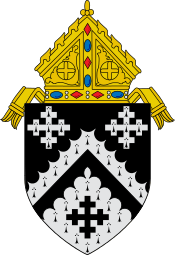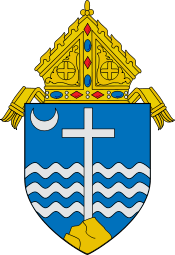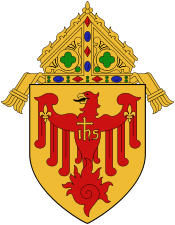Edward Francis Hoban
| The Most Reverend Edward F. Hoban D.D., S.T.D. | |
|---|---|
| Archbishop (personal title) of Cleveland | |
| Church | Roman Catholic Church |
| Archdiocese | Cincinnati |
| Diocese | Cleveland |
| See | Cleveland |
| Appointed | November 14, 1942 |
| In office | November 2, 1945 – September 22, 1966 |
| Predecessor | Joseph Schrembs |
| Successor | Clarence George Issenmann |
| Orders | |
| Ordination |
July 11, 1903 by James Edward Quigley |
| Consecration |
December 21, 1921 by George Mundelein |
| Personal details | |
| Born |
June 27, 1878 Chicago, Illinois |
| Died |
September 22, 1966 (aged 88) Cleveland, Ohio |
| Buried | Cathedral Resurrection Chapel |
| Previous post |
Auxiliary Bishop of Chicago Bishop of Rockford |
| Motto | Veni Lumen Cordium |
Ordination history of Edward Francis Hoban | |||||||||
|---|---|---|---|---|---|---|---|---|---|
| |||||||||
| |||||||||
Edward Francis Hoban (June 27, 1878 – September 22, 1966) was an American prelate and bishop (later archbishop) of the Roman Catholic Church. He served as Bishop of Rockford (1928-1942) and Bishop of Cleveland (1945-1966).
Biography
Edward Hoban was born in Chicago, Illinois, to William and Bridget (née O'Malley) Hoban, who were Irish immigrants. He attended St. Columbkille parochial school and then St. Ignatius High School in Chicago.[1] He went on St. Igantius College in Chicago, from where he obtained a Bachelor of Arts (1899) and a Master of Arts (1900).[2] He then studied at St. Mary's Seminary in Baltimore, Maryland.[3]
Hoban was ordained to the priesthood by Archbishop James Edward Quigley on July 11, 1903.[4] Father Hoban was assigned briefly as curate at St. Agnes Parish, Chicago, before furthering his studies in Rome at the Pontifical Gregorian University, where he earned a Doctor of Sacred Theology in 1906.[2]
Upon his return to the United States, he was named the assistant chancellor to Monsignor Edmund Dunne, the chancellor of the Archdiocese of Chicago in 1906. When Monsignor Dunne was named bishop of Peoria, Father Hoban was named chancellor for the Archdiocese of Chicago in 1910. He also served as professor and treasurer of Archbishop Quigley Preparatory Seminary.[3] In November 1916, Pope Benedict XV named him a papal chamberlain. During his tenure as chancellor Monsignor Hoban supervised the establishment of what was then called the Associated Catholic Charities of Chicago.[1]
On November 21, 1921, Hoban was appointed Auxiliary Bishop of Chicago and Titular Bishop of Colonia in Armenia by Pope Benedict XV. He received his episcopal consecration on the following December 21 from Cardinal George Mundelein, with Bishops Alexander Joseph McGavick and Thomas Edmund Molloy serving as co-consecrators.[4] As auxiliary bishop he served in several administrative posts, including as Vicar General in 1924, and in 1926 as the president of the International Eucharistic Congress. This was the first Congress held outside of Europe, and attracted more than one million pilgrims. Its success was attributed, in large part, to Bishop Hoban’s administrative skill and his ability to marshal and organize the efforts of clergy, religious and laity.[1]
Bishop of Rockford
Hoban was named the second Bishop of Rockford by Pope Pius XI on February 21, 1928, and later installed on the following May 15.[4] During his tenure, he opened many elementary and high schools, modernized charitable institutions, and established a diocesan newspaper.[3] He became an Assistant at the Pontifical Throne on November 25, 1937.[2]
On November 14, 1942, Hoban was appointed Coadjutor Bishop of Cleveland, Ohio, and Titular Bishop of Lystra by Pope Pius XII.[4] Upon the death of Archbishop Joseph Schrembs, Hoban succeed him as the sixth Bishop of Cleveland on November 2, 1945.[4] He encouraged people displaced by World War II to settle in Cleveland.[5] He also established national and ethnic parishes, but insisted that their parochial schools only teach English.[5] He helped rebuild and remodel St. John's Cathedral, and enlarged St. John's College.[3] Hoban centralized Parmadale Family Services, constructed additional nursing homes, and opened Holy Family Cancer Home for terminal cancer patients.[3] He opened a minor seminary and expanded the Newman Apostolate for Catholic students attending public universities and colleges.[3]
He was given the personal title of Archbishop on July 23, 1951.[4] He attended all four sessions of the Second Vatican Council between 1962 and 1965. During Hoban's 21-year-long tenure, the number of Catholics increased from 546,000 to 870,000, even though the Diocese of Cleveland lost six counties when the Diocese of Youngstown was erected in 1943.[3] He also established 61 parishes, 47 elementary schools, and a dozen high schools.[3]
Hoban later died at age 88. He is buried in the crypt of St. John's Cathedral.[3]
References
- 1 2 3 "The Most Reverend Edward F. Hoban, D.D.", Diocese of Rockford
- 1 2 3 Curtis, Georgina Pell (1961). The American Catholic Who's Who. XIV. Grosse Pointe, Michigan: Walter Romig.
- 1 2 3 4 5 6 7 8 9 "Hoban, Edward Francis". The Encyclopedia of Cleveland History.
- 1 2 3 4 5 6 "Archbishop Edward Francis Hoban". Catholic-Hierarchy.org.
- 1 2 Callahan, Nelson J. and William F. Hickey. Irish Americans and Their Communities of Cleveland.
| Catholic Church titles | ||
|---|---|---|
| Preceded by Peter Muldoon |
Bishop of Rockford 1928—1942 |
Succeeded by John Joseph Boylan |
| Preceded by Joseph Schrembs |
Bishop of Cleveland 1945—1966 |
Succeeded by Clarence George Issenmann |


